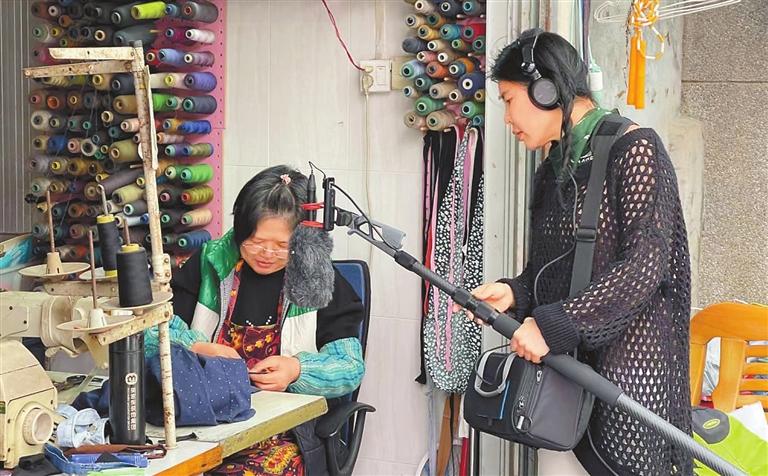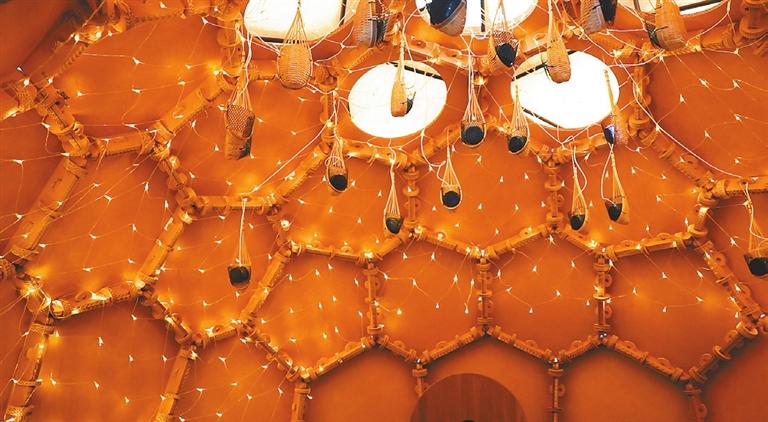

Kang Wei 1434163309@qq.com WHILE numerous artistic endeavors such as writing, painting, photography and sculpture have sought to depict Shenzhen’s extraordinary metamorphosis as a trailblazer of China’s reform and opening-up drive, for sound artist Li Yang, she firmly believes that sound can also be a powerful medium to chronicle Shenzhen’s historical journey and preserve its very essence in a unique and compelling way. Over the years, Li has meticulously amassed a treasure trove of sound recordings, culminating in the establishment of the City Sound Museum and the creation of China’s first urban sound map. Unlike conventional portrayals that rely on visual landmarks like towering skyscrapers and iconic boulevards, Li’s sound map ingeniously captures Shenzhen’s identity through the emotive medium of human voices and natural sounds. “Sound, as we understand it, is a vibration frequency, a wave,” she said during an interview with Shenzhen Daily. “Everything is vibrating, so everything is sound. Sound possesses the ability to evoke emotions, forge connections and convey meanings beyond words.” Source of fascination Li has been deeply fascinated by the world of sound from a young age, displaying a keen sensitivity to various auditory stimuli, such as the voices of her peers and the sounds produced when her parents scolded her. As years unfolded, Li started to get drawn to the distinct voices from the radio and found herself infatuated with different hosts’ melodious tones. Her passion for sound led her to engage in campus broadcasting when she was still a student. The magnetic pull of sound eventually guided Li’s path toward becoming a radio host herself. Speaking into the microphone, she discovered a profound sense of fulfillment, feeling it was “a unique privilege that others didn’t have,” Li recalled. Her ardent love affair with sound endured throughout her tenure at radio stations in both Shanxi Province and later in Shenzhen. She cherished every sound effect she utilized, meticulously preserving even the briefest snippets that last merely a single or half a second. “I possessed an almost childlike inclination to collect and safeguard these audio fragments,” she reminisced. Li said one of her most unforgettable encounters with sound took place in 2000 during a visit to the urban village of Baishizhou, where she sought to conduct an interview and collect background sounds. Her initial recording attempt proved challenging, from the mix of natural noises, everyday sounds and human voices. However, Li remained undeterred. She visited a second time, adopting a novel approach by pointing the microphone downward and stooping low while navigating the uneven gravel road, eventually achieving the desired effect she was aiming for. “The sounds I finally collected were vivid and rich in layers, capturing the simple and genuine exchanges among people sitting on the ground, the sounds of sewage flowing through households and the rhythmic clatter of carts rolling over the uneven cobblestone road,” Li said. “At that moment, I felt that this was the real world I had been seeking. I listened to it repeatedly and was deeply moved.” The experience planted a seed in Li’s heart, compelling her to explore and understand even more sounds, to listen attentively to the gentle whispers of the city, and to provide a platform for diverse voices to emerge and be heard. Sound museum Inspired by a friend’s suggestion, Li set up the City Sound Museum in 2016, one year after she quit her job at Shenzhen Radio Station. Later, she and her team created China’s first urban sound map, which was unveiled at an event in Shenzhen Book City CBD Store to mark the 38th anniversary of the establishment of the Shenzhen Special Economic Zone in 2018. The map contains 38 clips, which range from the sounds of urban village demolitions, construction workers’ voices, the sounds of crickets and cicadas, to the sounds of an old wooden door at a Hakka village and keyboards clacking inside Tencent’s office building. Each segment is assigned a unique QR code, which when scanned, allows listeners to hear the sounds. (Continued on P3) | 
